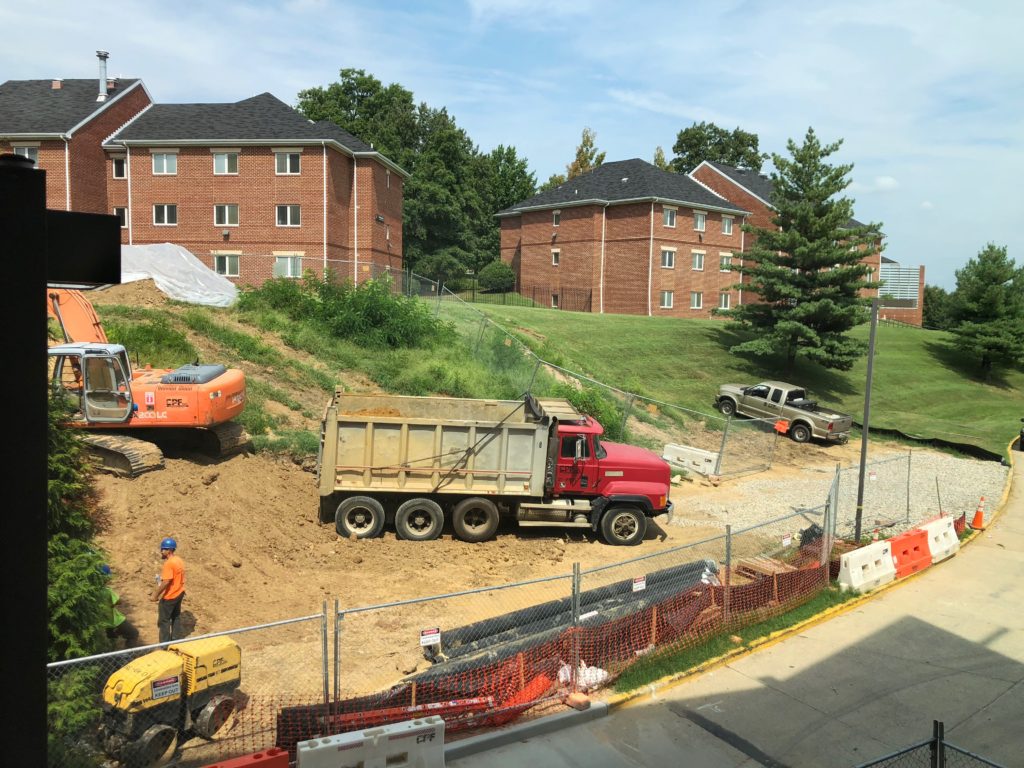Construction on Campus: What’s Happening and Why?


By Christopher Vitale
The construction on campus has been steadily expanding and effectively skewing the usage of roadways, walkways, and recreation spots. The University distributed an email last week, detailing the further changes and advancements in the construction plans, but many students are still left with questions unanswered about the larger implications of the work being done. Debra Nauta-Rodriguez, Associate Vice President for Facilities Planning and Management and University Architect, has been able to offer some answers regarding the concerns voiced by many students.
Up to the present, the campus has seen construction take place between Pangborn Hall and McCort-Ward Hall, around Maloney Hall, in front of and around the library, and on areas between the Pryz and the library among other places.
Now, the Facilities Department warns that the road between Father O’Connell Hall and McGivney Hall as well as the Pryz Lawn will soon undergo construction. This ensures more fencing and closures across campus space which in turn indicates that students will have to continue taking new detours to get to their destinations.
Freshman students Molly DiProspero, Molly Doolin, and Ethan Smith shared their agitation with the continuous changes in the University layout.
“It’s elongating my walks. I have to walk like five minutes out of my way everywhere I go,” DiProspero said.
She also agreed that no one is really sure what the construction is being done for, although she suggested that she had heard rumors about pipe altercations and a new Metro entrance.
In response to the prospect of a new Metro entrance possibly being in the works, Doolin expressed skepticism on the matter.
“What’s wrong with the one we have now?” she asked referring to the current Metro station located across the street from Gowan Hall.
And upon questioning about the future of the Pryz lawn, Ethan Smith said that he signed a petition that has circulated amongst students to stop the progression of construction to include closing the popular spot for students.
“Oh, I signed that petition— there’s a huge petition going around,” he remarked.
In response to the disquiet raised by students, Nauta-Rodriguez provided that the purpose of the construction is that it is part of the Campus Energy Project which handles fixing problems with utility distribution. This includes working on many underground pipes involved with the circulation of hot and cold water. The issue is that construction work is dependent upon the favorability of the weather, and due to the extreme weather circumstances that have been observed in the past year, there have been many delays made to the progress of the execution of the projects.
Fortunately, Nauta-Rodriquez assured that the University is aiming to take advantage of the new developments in physical infrastructure to enrich campus beautification. While this does not include a new Metro entrance, it will encompass a newly designed and more appealing walkway replacing the road in front of Pangborn Hall and leading to the Metro.
Nauta-Rodriguez also expressed that the Pryz lawn closure, while unfavorable, is essential to the completion of the Campus Energy Project and that it is scheduled to re-open around mid-April, thus not interfering with Graduation festivities.
“While our efforts are always trained on minimizing impacts to the everyday campus experience, focused attention is given to special events such as academic year-end activities and Graduation,” Nauta-Rodriguez said.
Hopefully these words can give some peace of mind to worried students in regards to how the University will handle Graduation amid the campus construction projects.
“While the temporary disruptions are indeed burdensome for all of us in the short term, the final outcome of the project will serve generations to come with improved comfort in our living, working and learning environments,” Nauta-Rodriguez also noted.
So although the seemingly endless detours, drilling, and reroutes are understandably irritating, perhaps the University community has a lot of benefits to look forward to concerning the future of the campus which will help to advance the status and capabilities of Catholic University in the long run.







